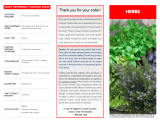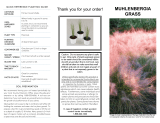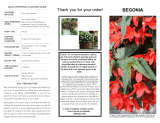Page is loading ...

*Image on cover is representative of the type of plant(s) in this offer and
not necessarily indicative of actual size or color for the included variety
.
LEMON GRASS
Thank you for your order!
PLANT WARRANTY
We warrant perennials for 1 year and
annuals for 90 days from the time of the
original shipment. If for any reason you
are dissatisfied, we will replace your plant
with a similar or comparable one, at no
charge. If your replacement is not available
or it is too late in the season to ship, it will
reship the following shipping season.
If you have any questions or concerns
about your order, please contact us at 888-
593-3644 or [email protected].
Caution: Do not assume any plant is safe
to eat. Only parts of plants expressly grown
to be eaten should be considered edible.
As with any product that is not food, care
should be taken to make sure that small
children and pets do not ingest any part of
a plant that is not expressly grown to be
eaten.
Unless specifically stated, this product is
intended for ornamental horticultural use
only and is not intended for consumption
or ingestion by humans or pets. Most
plants are harmless but some contain toxic
substances which can cause adverse health
effects. Furthermore, some individuals and
some animals are sensitive or allergic to
certain plants and precautions should be
taken to limit or avoid physical contact with
particular plants. Some plants have thorns
or spines that can be painful if handled.
In case of ingestion contact a poison
control center immediately.
1-800-222-1222
SOI L PREPA RAT ION
Full sun.
LIGHT/SUN
EXPOSURE
USDA HARDINESS
ZONES
PLANTING
DISTANCE
IN-GROUND
MATURE
HEIGHT / SPREAD
3 to 5 feet tall with a 2 to 3 foot
spread.
Edible.
Great for containers.
Can be used to flavor soups,
curries, meats and more.
TIME TO REACH
MATURITY
FACTS OF NOTE
PLANT TYPE
Annual/Edible.
CONTAINER SIZE
One plant per 12-inch or larger
container.
We recommend having your soil tested periodically by
your local County Extension Office (www.nifa.usda.gov/
extension or by calling 1-800-333-4636). A soil test can
determine if your soil needs any amendments to enhance
the growth and performance of your plants.
Ideal garden soil is easy to dig in and drains well while still
holding the nutrients and water vital to plant growth. To
prepare a bed for in-ground planting, spade or till the soil
to a depth of roughly 12-18 inches. Next, spread a 2-4 inch
layer of organic matter such as compost, shredded leaves
or peat moss over the soil and mix well.
QUI CK R EFERENCE PLANTING GUIDE
Not winter hardy.
We recommend planting in
containers so you can move the
plants indoors before the first frost.
At least 2 feet apart.
3 months.

FEEDING
WATERINGWINTERIZING
Lemon grass should be planted in containers and
moved indoors before the first frost. Select a room
that is bright, preferably one with southern exposure.
Indoors, plants tend to dry out from a lack of humidity.
To boost the humidity level around your plants, fill a
shallow tray with gravel and water then place the
pots in the tray. The water level should be slightly
below the gravel so that the pots are not submerged
in water. As the water evaporates, it will create a
more humid environment for your plants.
Watering should be reduced significantly while the
plants are indoors. Do not overwater or allow your
plants to sit in water.
In the spring when temperatures begin to rise, ease
the plants into a full watering schedule and move
them back outdoors for the summer.
CONTINUING CARE (Continued)
CONTINUING CARE
PLANTING INSTRUCTIONS ( Con tinued )
PLANTING I NSTRUCTIONS
Important:
Thoroughly hydrate the plant by submersing
the root zone in a container of water for 10 minutes while
you prepare for planting.
We strongly recommend planting in a container in order
to properly protect the plant from winter damage. Use the
following instructions as a guide for container planting.
Fill the container with soil to within 4 inches of the
top. Remove the pot and prepare the root ball for
planting by gently disturbing the surface roots with
your fingers, fork, or gardening tool and pruning
any damaged roots. Dig a hole in the soil to insert
the lower part of the root ball.
Once the plant is properly positioned in the pot,
begin filling the pot with soil. Work the soil around
the root ball with your hands, firming the soil
around the plant with your fingers. When the hole is
filled, tamp the soil to remove any air pockets.
Water well and, if necessary, adjust the plant so it is
upright and add additional soil if needed, Check to
be sure the plant is not planted too deeply. If it is,
raise the plant carefully and re-firm the soil.
A
B
C
Adequate and consistent watering is essential during
your plant's first year in the garden. Infrequent, long
soakings of water that thoroughly saturate the soil
are more effective than frequent, light applications of
water.
Due to variable geographical and environmental
conditions, a specific watering schedule is difficult to
define. However, as a rule of thumb, you should not
allow the soil or the original root ball to completely
dry out. During the first summer, you may need to
water as often as every few days in periods of
drought and extreme summer heat. To determine if
your plant needs water, dig a few inches into the soil
next to the plant. If the soil is dry 2-3 inches below the
surface, it is time to water.
Overwatering can be as damaging as under watering.
Be sure that the area surrounding your plant has
adequate drainage to move water away from the
plant. If you choose to plant in a container, always
select one with drainage holes to prevent your
plant's roots from sitting in water.
Feed your plants once every 2-3 weeks during the
growing season with a water-soluble fertilizer.
Discontinue feeding after September 1st to allow
your plants to prepare for winter. Resume fertilizing
when new growth appears in spring.
Apply a 2-4 inch layer of shredded bark, compost,
leaves, straw or other organic matter around your
plants to promote moisture retention, maintain
even soil temperatures and discourage weed
growth. Replenish the mulch as needed.
Keep the area around your plants free of weeds.
Weeds compete with surrounding plants for food,
water and light. Walk around the garden periodically
and pull weeds, including the roots, as soon as you
see them.
Your plants have been shipped to you in pots. We urge
you to remove them from the shipping box and plant
them as soon as possible. Should planting be delayed due
to weather or other unforeseen circumstances, roll the
plastic bag down around each plant and place them near
a bright window or other sunny location. Keep them well-
watered in their pots until permanently planted. Once
planted, they begin setting roots and, as the weather
warms, begin showing new growth. Please plant as soon
as possible, provide reasonable care and be patient.
LEMON GRASS
The foliage on potted plants may appear slightly wilted or
yellow upon arrival. This is due to the stress of shipping
and is usually nothing to worry about. Water the plant
thoroughly, place it in a shady location for a few days and
remove any foliage that does not recover.
Harvest lemon grass by snapping or cutting mature
stalks off as close to the root system as possible. For
best results, choose stalks that are at least 1/4 inch
thick. Next, peel away the outer leaves and remove
and discard any woody portions. Fresh lemon grass
stalks can be used right away or frozen for up to six
months, and the leaves can be dried to use in teas
or soups.
OUT OF THE BOX
HARVESTING MULCHINGWEEDING
SHIPPED AS SHOWN
/







